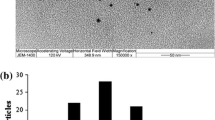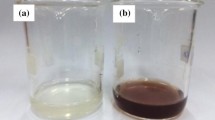Abstract
In this study, a novel intelligent antimicrobial model was constructed based on the antibiotic properties of nano-silver and the ion-exchange response of dehydrated alginate (Alg) gel. Through the process of reducing reaction, hydrogel formation and dehydration, the model composed of Alg and nano-silver was fabricated. The distinguished feature of this model lies in its antimicrobial properties and biocompatibility. In this model, the releasing level of nano-silver is determined by the outside-in swelling of Alg composites, which is further self-regulated by the volume of wound exudates. The results showed that the released nano-silver was intelligently maintained within a constant concentration range, so that it could be further designed to exhibit antimicrobial activity without cytotoxicity. Furthermore, the murine wound infection model conducted with these composites resulted in a significant decrease of bacteria number. The self-regulating swelling feature based on the ion-exchange response of Alg along with the controlled release of nano-silver made this composite a promising intelligent model for antimicrobial wound dressing applications.








Similar content being viewed by others
References
Travan A, Pelillo C, Donati I, Marsich E, Benincasa M, Scarpa T, et al. Non-cytotoxic silver nanoparticle-polysaccharide nanocomposites with antimicrobial activity. Biomacromolecules. 2009;10:1429–35.
Ong SY, Wu J, Moochhala SM, Tan MH, Lu J. Development of a chitosan-based wound dressing with improved hemostatic and antimicrobial properties. Biomaterials. 2008;29:4323–32.
Lee D, Cohen RE, Rubner MF. Antibacterial properties of Ag nanoparticle loaded multilayers and formation of magnetically directed antibacterial microparticles. Langmuir. 2005;21:9651–9.
Mooney EK, Lippitt C, Friedman J. Silver dressings. Plast Reconstr Surg. 2006;117:666–9.
Agarwal A, Weis TL, Schurr MJ, Faith NG, Czuprynski CJ, McAnulty JF, et al. Surfaces modified with nanometer-thick silver-impregnated polymeric films that kill bacteria but support growth of mammalian cells. Biomaterials. 2010;31:680–90.
Carlson C, Hussain SM, Schrand AM, Braydich-Stolle LK, Hess KL, Jones RL, et al. Unique cellular interaction of silver nanoparticles: size-dependent generation of reactive oxygen species. J Phys Chem B. 2008;112:13608–19.
Li L, Sun J, Li XR, Zhang Y, Wang ZX, Wang CR, et al. Controllable synthesis of monodispersed silver nanoparticles as standards for quantitative assessment of their cytotoxicity. Biomaterials. 2011;33:1714–21.
Hussain SM, Hess KL, Gearhart JM, Geiss KT, Schlager JJ. In vitro toxicity of nanoparticles in BRL 3A rat liver cells. Toxicol In Vitro. 2005;19:975–83.
Trop M, Novak M, Rodl S, Hellbom B, Kroell W, Goessler W. Silver-coated dressing acticoat caused raised liver enzymes and argyria-like symptoms in burn patient. J Trauma. 2006;60:648–52.
Sharma S, Chockalingam S, Sanpui P, Chattopadhyay A, Ghosh SS. Silver nanoparticles impregnated alginate–chitosan-blended nanocarrier induces apoptosis in human glioblastoma cells. Adv Healthc Mater. 2014;3:106–14.
Guthrie KM, Agarwal A, Tackes DS, Johnson KW, Abbott NL, Murphy CJ, et al. Antibacterial efficacy of silver-impregnated polyelectrolyte multilayers immobilized on a biological dressing in a murine wound infection model. Ann Surg. 2006;256:371–7.
Panacek A, Kolar M, Vecerova R, Prucek R, Soukupova J, Krystof V, et al. Antifungal activity of silver nanoparticles against Candida spp. Biomaterials. 2009;30:6333–40.
Hsu SH, Tseng HJ, Lin YC. The biocompatibility and antibacterial properties of water borne polyurethane-silver nanocomposites. Biomaterials. 2010;31:6796–808.
Mendes PM. Stimuli-reponsive surfaces for bio-applications. Chem Soc Rev. 2008;37:2512–29.
Pavlukhina S, Sukhishvili S. Polymer assemblies for controlled delivery of bioactive molecules from surfaces. Adv Drug Deliv Rev. 2011;63:822–36.
Brun-Graeppi AKAS, Richard C, Bessodes M, Scherman D, Merten OW. Cell microcarriers and microcapsules of stimuli-responsive polymers. J Control Release. 2011;149:209–24.
Kim YJ, Ebara M, Aoyagi T. A smart hyperthermia nanofiber with switchable drug release for inducing cancer apoptosis. Adv Funct Mater. 2013;23:5753–61.
Delcea M, Mohwald H, Skirtach AGJ. Stimuli-resoponsive LbL capsules and nanoshells for drug delivery. Adv Drug Deliv Rev. 2011;63:730–47.
Ionov L. Biomimetic hydrogel-based actuating systems. Adv Funct Mater. 2013;23:4555–70.
Alvarez-Lorenzo C, Blanco-Fernandez B, Puga AM, Concheiro A. Crosslinked ionic polysaccharides for stimuli-sensitive drug delivery. Adv Drug Deliv Rev. 2013;65:1148–71.
Chan AW, Whitney RA, Neufeld RJ. Kinetic controlled synthesis of ph-responsive network alginate. Biomacromolecules. 2008;9:2536–45.
Chan AW, Whitney RA, Neufeld RJ. Semisynthesis of a controlled stimuli-responsive alginate hydrogel. Biomacromolecules. 2009;10:609–16.
Neibert K, Gopishetty V, Grigoryev A, Tokarev I, Al-Hajaj N, Vorstenbosch J, et al. Wound-healing with mechanically robust and biodegradable hydrogel fibers loaded with silver nanoparticles. Adv Healthc Mater. 2012;1:621–30.
Sriamornsak P, Thirawong N, Korkerd K. Swelling, erosion and release behavior of alginate-based matrix tablets. Eur J Pharm Biopharm. 2007;66:435–50.
White JC, Saffer EM, Bhatia SR. Alginate/PEO-PPO-PEO composite hydrogels with thermally-active plasticity. Biomacromolecules. 2013;14:4456–64.
Catalina NC, Ciocoin ON, Staikos G, Vasile C. Thermoresponsive sodium alginate-g-poly(N-isopropylacrylamide) copolymers III. Solution Properties. J Appl Polym Sci. 2013;127:3340–8.
Wang C, Huang X, Deng W, Chang C, Hang R, Tang B. A nano-silver composite based on the ion-exchange response for the intelligent antibacterial applications. Mat Sci Eng C Mater. 2014;41:134–41.
Lee KY, Mooney DJ. Alginate: properties and biomedical applications. Prog Polym Sci. 2012;37:106–26.
Li Z, Lee D, Sheng XX, Cohen RE, Rubner MF. Two-level antibacterial coating with both release-killing and contact-killing capabilities. Langmuir. 2006;22:9820–3.
Zhao QL, Wang SW, Xie YY, Zheng WF, Wang Z, Xiao L, et al. A rapid screening method for wound dressing by cell-on-a-chip device. Adv Healthc Mater. 2012;1:560–6.
Acknowledgments
This work was supported by the Natural Science Foundation of Shanxi Province (2012021021-7), the National Nature Science Foundation of China (31300808 and 31400815) and Scientific and Technologial Innovation Programs of Higher Education Institutions in Shanxi (201417) and Taiyuan University of Technology Graduate Innovation Fund (S2014081).
Author information
Authors and Affiliations
Corresponding author
Rights and permissions
About this article
Cite this article
Huang, X., Liu, Y., Chang, C. et al. A self-regulating antimicrobial model based on the ion-exchange stimuli. J Mater Sci: Mater Med 26, 208 (2015). https://doi.org/10.1007/s10856-015-5546-8
Received:
Accepted:
Published:
DOI: https://doi.org/10.1007/s10856-015-5546-8




